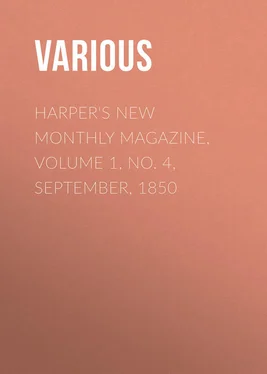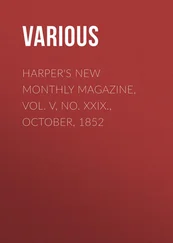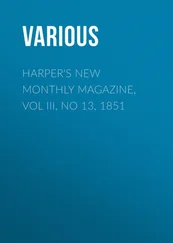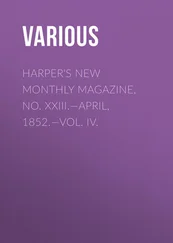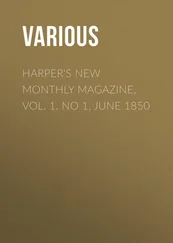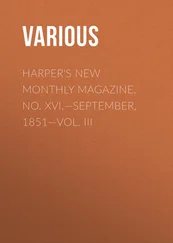Various - Harper's New Monthly Magazine, Volume 1, No. 4, September, 1850
Здесь есть возможность читать онлайн «Various - Harper's New Monthly Magazine, Volume 1, No. 4, September, 1850» — ознакомительный отрывок электронной книги совершенно бесплатно, а после прочтения отрывка купить полную версию. В некоторых случаях можно слушать аудио, скачать через торрент в формате fb2 и присутствует краткое содержание. Издательство: Иностранный паблик, Жанр: periodic, foreign_edu, на английском языке. Описание произведения, (предисловие) а так же отзывы посетителей доступны на портале библиотеки ЛибКат.
- Название:Harper's New Monthly Magazine, Volume 1, No. 4, September, 1850
- Автор:
- Издательство:Иностранный паблик
- Жанр:
- Год:неизвестен
- ISBN:нет данных
- Рейтинг книги:5 / 5. Голосов: 1
-
Избранное:Добавить в избранное
- Отзывы:
-
Ваша оценка:
- 100
- 1
- 2
- 3
- 4
- 5
Harper's New Monthly Magazine, Volume 1, No. 4, September, 1850: краткое содержание, описание и аннотация
Предлагаем к чтению аннотацию, описание, краткое содержание или предисловие (зависит от того, что написал сам автор книги «Harper's New Monthly Magazine, Volume 1, No. 4, September, 1850»). Если вы не нашли необходимую информацию о книге — напишите в комментариях, мы постараемся отыскать её.
Harper's New Monthly Magazine, Volume 1, No. 4, September, 1850 — читать онлайн ознакомительный отрывок
Ниже представлен текст книги, разбитый по страницам. Система сохранения места последней прочитанной страницы, позволяет с удобством читать онлайн бесплатно книгу «Harper's New Monthly Magazine, Volume 1, No. 4, September, 1850», без необходимости каждый раз заново искать на чём Вы остановились. Поставьте закладку, и сможете в любой момент перейти на страницу, на которой закончили чтение.
Интервал:
Закладка:
How differently would she have “watched and waited” had she been tainted by vanity, or fixed her soul on the mere triumphs of “literary reputation.” While firm to her own creed, she fully enjoyed the success of those who scramble up – where she bore the standard to the heights – of Parnassus; she was never more happy than when introducing some literary “Tyro” to those who could aid or advise a future career. We can speak from experience of the warm interest she took in the Hospital for the cure of Consumption, and the Governesses’ Benevolent Institution; during the progress of the latter, her health was painfully feeble, yet she used personal influence for its success, and worked with her own hands for its bazaars. She was ever aiding those who could not aid themselves; and all her thoughts, words, and deeds, were evidence of her clear, powerful mind, and kindly loving heart; her appearance in the London coteries was always hailed with interest and pleasure; to the young she was especially affectionate; but it was in the quiet mornings, or in the long twilight evenings of summer, when visiting her cherished friends at Shirley Park, in Kensington-square, or wherever she might be located for the time – it was then that her former spirit revived and she poured forth anecdote and illustration, and the store of many years’ observation, filtered by experience and purified by that delightful faith to which she held – that “all things work together for good to them that love the Lord.” She held this in practice, even more than in theory: you saw her chastened yet hopeful spirit beaming forth from her gentle eyes, and her sweet smile can never be forgotten. The last time we saw her, was about two years ago – in Bristol – at her brother, Dr. Porter’s house in Portland-square: then she could hardly stand without assistance, yet she never complained of her own suffering or feebleness – all her anxiety was about the brother – then dangerously ill, and now the last of “his race.” Major Porter, it will be remembered, left five children, and these have left only one descendant – the daughter of Sir Robert Ker Porter and the Russian Princess whom he married, a young Russian lady, whose present name we do not even know.
We did not think at our last leave-taking that Miss Porter’s fragile frame could have so long withstood the Power that takes away all we hold most dear; but her spirit was at length summoned, after a few days’ total insensibility, on the 24th of May.
We were haunted by the idea that the pretty cottage at Esher, where we spent those happy hours, had been treated even as “Mrs. Porter’s Arcadia” at Thames Ditton – now altogether removed; and it was with a melancholy pleasure we found it the other morning in nothing changed; it was almost impossible to believe that so many years had passed since our last visit. While Mr. Fairholt was sketching the cottage, we knocked at the door, and were kindly permitted by two gentle sisters, who now inhabit it, to enter the little drawing-room and walk round the garden; except that the drawing-room has been re-papered and painted, and that there were no drawings and no flowers, the room was not in the least altered; yet to us it seemed like a sepulchre, and we rejoiced to breathe the sweet air of the little garden, and listen to a nightingale, whose melancholy cadence harmonized with our feelings.
“Whenever you are at Esher,” said the devoted daughter, the last time we conversed with her, “do visit my mother’s tomb.” We did so. A cypress flourishes at the head of the grave; and the following touching inscription is carved on the stone:
SHOOTING STARS AND METEORIC SHOWERS
From every region of the globe and in all ages of time within the range of history, exhibitions of apparent instability in the heavens have been observed, when the curtains of the evening have been drawn. Suddenly, a line of light arrests the eye, darting like an arrow through a varying extent of space, and in a moment the firmament is as sombre as before. The appearance is exactly that of a star falling from its sphere, and hence the popular title of shooting star applied to it. The apparent magnitudes of these meteorites are widely different, and also their brilliancy. Occasionally, they are far more resplendent than the brightest of the planets, and throw a very perceptible illumination upon the path of the observer. A second or two commonly suffices for the individual display, but in some instances it has lasted several minutes. In every climate it is witnessed, and at all times of the year, but most frequently in the autumnal months. As far back as records go, we meet with allusions to these swift and evanescent luminous travelers. Minerva’s hasty flight from the peaks of Olympus to break the truce between the Greeks and Trojans, is compared by Homer to the emission of a brilliant star. Virgil, in the first book of the Georgics, mentions the shooting stars as prognosticating weather changes:
“And on, before tempestuous winds arise,
The seeming stars fall headlong from the skies,
And, shooting through the darkness, gild the night
With sweeping glories and long trains of light.”
Various hypotheses have been framed to explain the nature and origin of these remarkable appearances. When electricity began to be understood, this was thought to afford a satisfactory explanation, and the shooting stars were regarded by Beccaria and Vassali as merely electrical sparks. When the inflammable nature of the gases became known, Lavosier and Volta supposed an accumulation of hydrogen in the higher regions of the atmosphere, because of its inferior density, giving rise by ignition to the meteoric exhibitions. While these theories of the older philosophers have been shown to be untenable, there is still great obscurity resting upon the question, though we have reason to refer the phenomena to a cause exterior to the bounds of our atmosphere. Upon this ground, the subject assumes a strictly astronomical aspect, and claims a place in a treatise on the economy of the solar system.
The first attempt accurately to investigate these elegant meteors was made by two university students, afterward Professors Brandes of Leipsic, and Benzenberg of Dusseldorf, in the year 1798. They selected a base line of 46,200 feet, somewhat less than nine English miles, and placed themselves at its extremities on appointed nights, for the purpose of ascertaining their average altitude and velocity. Out of twenty-two appearances identified as the same, they found,
7 under 45 miles
9 between 45 and 90 miles
5 above 90 miles
1 above 140 miles.
The greatest observed velocity gave twenty-five miles in a second. A more extensive plan was organized by Brandes in the year 1823, and carried into effect in the neighborhood of Breslaw. Out of ninety-eight appearances, the computed heights were,
4 under 15 miles
15 from 15 to 30 miles
22 from 30 to 45 miles
33 from 45 to 70 miles
13 from 70 to 90 miles
6 above 90 miles
5 from 140 to 460 miles.
The velocities were between eighteen and thirty-six miles in a second, an average velocity far greater than that of the earth in its orbit.
Читать дальшеИнтервал:
Закладка:
Похожие книги на «Harper's New Monthly Magazine, Volume 1, No. 4, September, 1850»
Представляем Вашему вниманию похожие книги на «Harper's New Monthly Magazine, Volume 1, No. 4, September, 1850» списком для выбора. Мы отобрали схожую по названию и смыслу литературу в надежде предоставить читателям больше вариантов отыскать новые, интересные, ещё непрочитанные произведения.
Обсуждение, отзывы о книге «Harper's New Monthly Magazine, Volume 1, No. 4, September, 1850» и просто собственные мнения читателей. Оставьте ваши комментарии, напишите, что Вы думаете о произведении, его смысле или главных героях. Укажите что конкретно понравилось, а что нет, и почему Вы так считаете.
